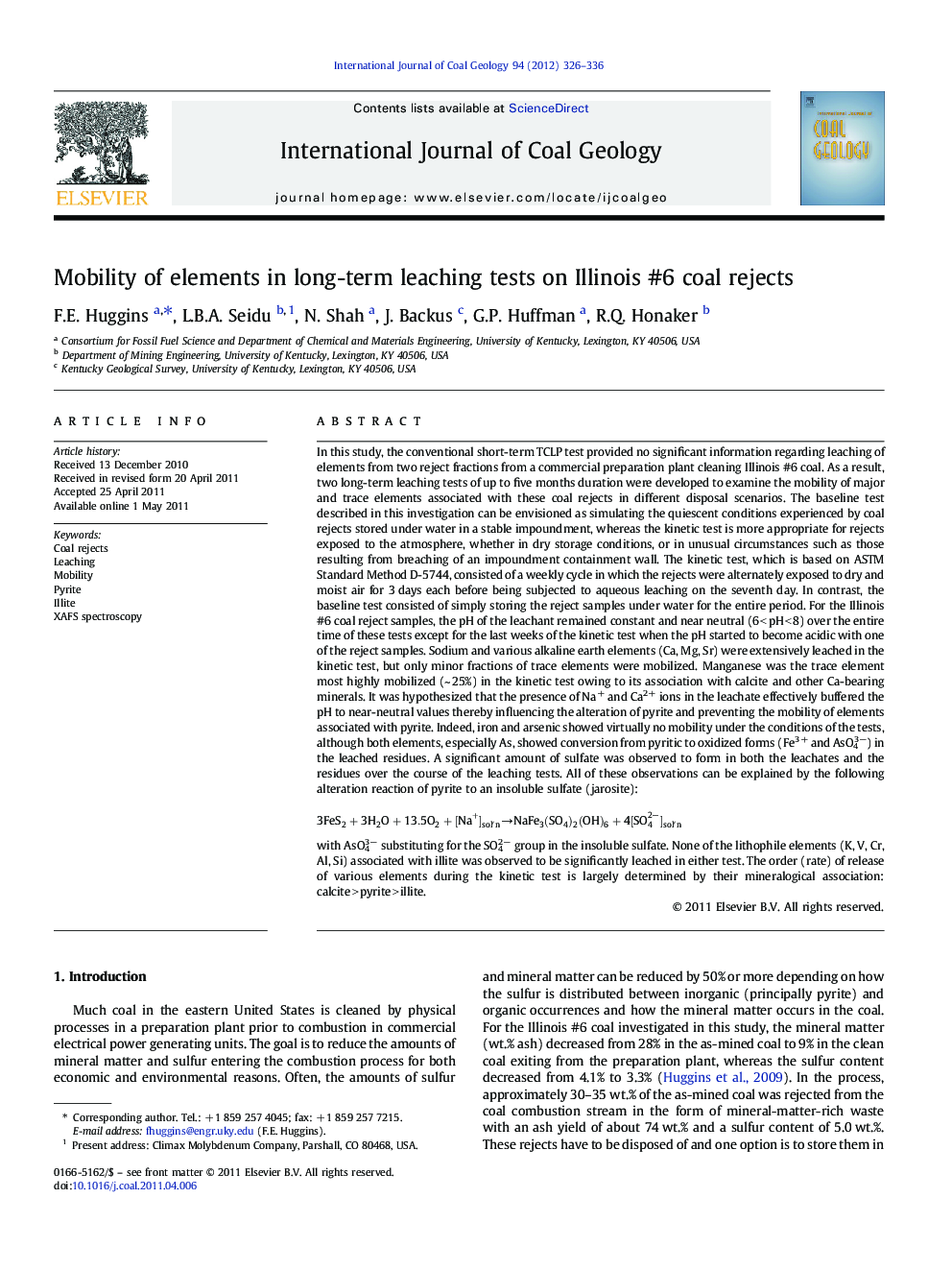| کد مقاله | کد نشریه | سال انتشار | مقاله انگلیسی | نسخه تمام متن |
|---|---|---|---|---|
| 1753666 | 1522599 | 2012 | 11 صفحه PDF | دانلود رایگان |

In this study, the conventional short-term TCLP test provided no significant information regarding leaching of elements from two reject fractions from a commercial preparation plant cleaning Illinois #6 coal. As a result, two long-term leaching tests of up to five months duration were developed to examine the mobility of major and trace elements associated with these coal rejects in different disposal scenarios. The baseline test described in this investigation can be envisioned as simulating the quiescent conditions experienced by coal rejects stored under water in a stable impoundment, whereas the kinetic test is more appropriate for rejects exposed to the atmosphere, whether in dry storage conditions, or in unusual circumstances such as those resulting from breaching of an impoundment containment wall. The kinetic test, which is based on ASTM Standard Method D-5744, consisted of a weekly cycle in which the rejects were alternately exposed to dry and moist air for 3 days each before being subjected to aqueous leaching on the seventh day. In contrast, the baseline test consisted of simply storing the reject samples under water for the entire period. For the Illinois #6 coal reject samples, the pH of the leachant remained constant and near neutral (6 < pH < 8) over the entire time of these tests except for the last weeks of the kinetic test when the pH started to become acidic with one of the reject samples. Sodium and various alkaline earth elements (Ca, Mg, Sr) were extensively leached in the kinetic test, but only minor fractions of trace elements were mobilized. Manganese was the trace element most highly mobilized (~ 25%) in the kinetic test owing to its association with calcite and other Ca-bearing minerals. It was hypothesized that the presence of Na+ and Ca2+ ions in the leachate effectively buffered the pH to near-neutral values thereby influencing the alteration of pyrite and preventing the mobility of elements associated with pyrite. Indeed, iron and arsenic showed virtually no mobility under the conditions of the tests, although both elements, especially As, showed conversion from pyritic to oxidized forms (Fe3+ and AsO43−) in the leached residues. A significant amount of sulfate was observed to form in both the leachates and the residues over the course of the leaching tests. All of these observations can be explained by the following alteration reaction of pyrite to an insoluble sulfate (jarosite):3FeS2 + 3H2O + 13.5O2 + [Na+]sol'n → NaFe3(SO4)2(OH)6 + 4[SO42−]sol'nwith AsO43− substituting for the SO42− group in the insoluble sulfate. None of the lithophile elements (K, V, Cr, Al, Si) associated with illite was observed to be significantly leached in either test. The order (rate) of release of various elements during the kinetic test is largely determined by their mineralogical association: calcite > pyrite > illite.
Research Highlights
► Trace element mobilities in Illinois #6 rejects are evaluated in two leaching tests.
► Major elements (Na, Ca, etc.) more readily leached than most trace elements.
► Leached Na+ and Ca2+ keep leachate pH near neutral, delaying pyrite alteration.
► Trace element mobilities reflect mineral association: calcite > pyrite > illite.
Journal: International Journal of Coal Geology - Volume 94, 1 May 2012, Pages 326–336